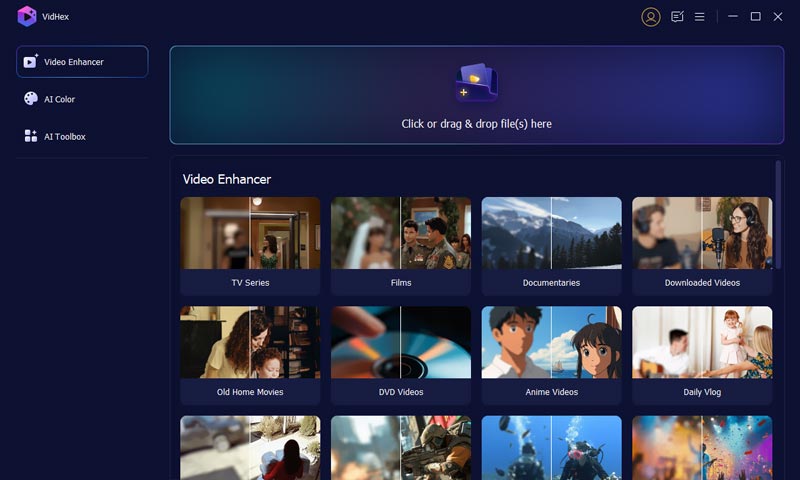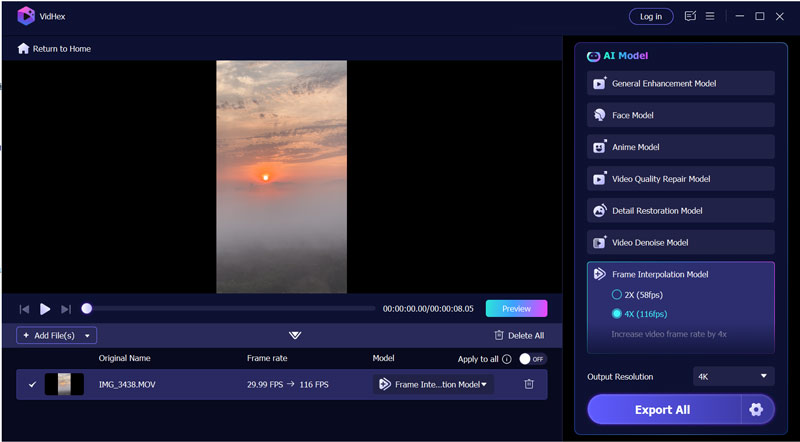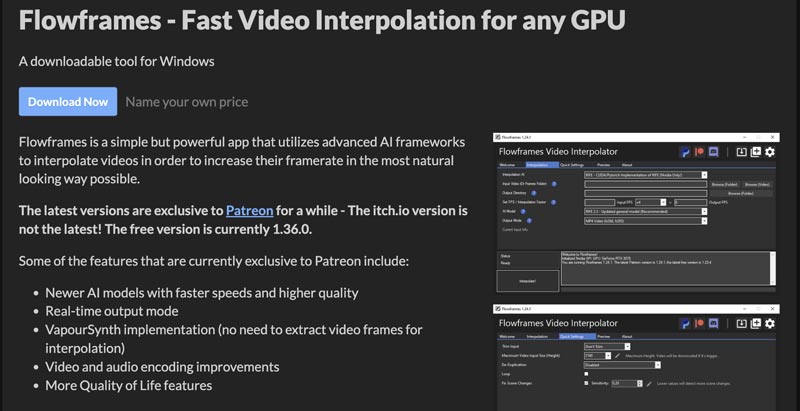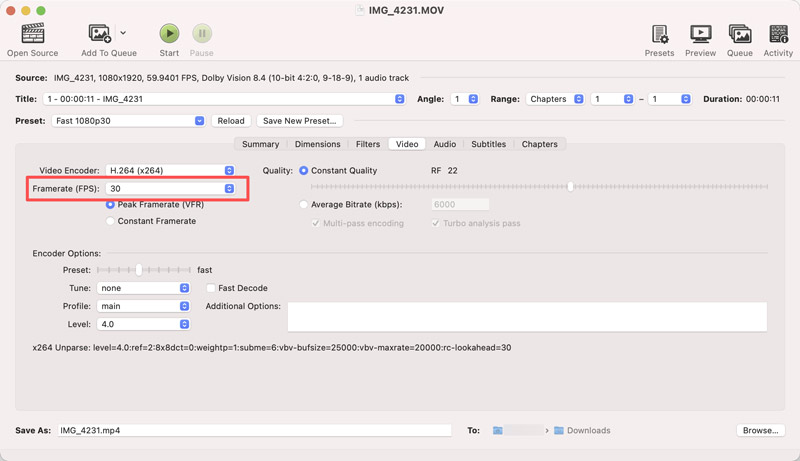To deal with the potential judder of low-frame-rate media, frame rate conversion tools like SmoothVideo Project (SVP) emerged as a pioneering solution. They use advanced frame interpolation technologies to transform standard 24fps or 30fps videos into 60fps or higher. The high-frame-rate (HFR) content often delivers a higher viewing experience.
However, is it necessary to use frame interpolation software like SVP? Are these AI-powered enhancers a better new generation choice?
If you are unsatisfied with the complex setup of SVP or its real-time performance, or you are curious about similar tools out there, check the three SVP alternatives. This post gives a quick comparison of the top contenders available today. You can select the perfect tool for your frame interpolation needs.

SVP is a real-time software solution that uses frame interpolation to increase the frame rate of videos during playback. It is mainly used to smooth the motion in TV shows, movies, and other videos. Generally, transforming the standard 24 or 30 fps (frames-per-second) video to 60 fps or higher will deliver a fluid, higher viewing experience.

You should know that SVP is not a media player, and it does not work alone. It integrates into a video player for frame rate conversion. For instance, SVP can be installed as a direct filter within a player like MPC-HC. SVP can analyze consecutive frames in real-time, detect the motion of objects, and then generate new frames between the original ones.

This section gives a quick comparison of SVP and other similar frame interpolation software. You can compare their key differences through the overview table.
| Feature | SVP | Aiseesoft VidHex | Flowframes | HandBrake |
| Core Technology | Traditional Optical Flow NVIDIA Optical Flow RIFE neural network interpolation NVIDIA TensorRT |
AI-powered neural networks | AI-powered | Traditional algorithms (via Filters) |
| Output Quality | Good, but may produce artifacts with complex motion | Excellent, with fewer artifacts on complex scenes | Excellent, very sharp | Good, may soften video and introduce blur |
| Frame Rate Configuration | Real-time processing and adjustment, highly flexible | Various AI models Preset multipliers (2x, 3x, 4x) & custom FPS |
Flexible multipliers and custom FPS | Standard FPS values (30fps, 60fps, etc.) |
| Maximum FPS | Hardware dependent | Up to 4x source framerate (e.g., 120fps from 30fps) | Limited by model and hardware | Limited to standard FPS values |
| Processing Mode | Real-time during playback | Pre-processing | Pre-processing | Pre-processing |
| Ease of Use | Complex setup and tuning | Very easy-to-use, user-friendly | Requires some technical understanding | Powerful but not interpolation-focused |
| Other AI Features | No | Yes (Video Upscaling, Enhancement, Stabilization, colorization, etc.) | Focused on frame interpolation | No |
| Pricing | Free (with paid version) | Paid (with free trial) | Free (Donation-supported) | Free (Open-source/Donationware) |
With the table above, you can tell that SVP excels at real-time frame rate conversion. New AI-powered enhancers like VidHex and Flowframes prioritize pre-processed and can give higher-quality output. You can explore three compelling alternatives to SVP in this part.
VidHex is an all-featured video frame interpolation, upscaling, and enhancement tool powered by advanced AI. As you can see from the above table, it offers various AI models for different enhancement needs. This SVP alternative lets you increase frame rate, upscale resolution, stabilize shaky footage, reduce noise, and optimize colors.
100% Secure. No Ads.
100% Secure. No Ads.


If SVP’s real-time processing frustrates you, VidHex’s AI-driven approach often automatically sharpens or denoises the videos. It can generate higher-quality, more natural-looking results. For a non-technical user, this SVP alternative is a good choice. It doesn’t require a professional learning curve with AI technology.
Flowframes is a powerful SVP alternative that acts as a front-end GUI for video interpolation. It supports several advanced AI interpolation models like RIFE and DAIN. Like VidHex, Flowframes is used for pre-processing videos, not real-time playback. It often produces sharper and artifact-free results, even when dealing with complex textures and motion.

For casual users and beginners, the software still needs a steeper learning curve. Moreover, this SVP alternative heavily relies on a powerful NVIDIA GPU for fast processing speeds. Flowframes is currently only available for Windows.
HandBrake is a famous, open-source video transcoder that allows basic frame interpolation. It is designed with a Frame Rate feature for users to use its interpolation algorithms. It is not a dedicated frame rate conversion tool. If you have already installed it on your computer, you can use it to increase the frame rate. However, HandBrake uses older, non-AI algorithms. It may introduce motion blur or ghosting artifacts. Frame interpolation is not the primary function of HandBrake.

Question 1. Does SVP work with VLC?
As mentioned, SVP can work perfectly with media players like MPC-HC. When it comes to the popular VLC, the specific usages and scenarios may vary. The short answer is: Yes, SVP can technically work with VLC. However, it is not the recommended method, even though the SVP developers officially state that VLC is a supported player. The setup is frustrating, and the frame rate conversion results are unreliable. You must configure SVP to act as an external filter for VLC. If you are a casual user who wants to use SVP to its full potential, switch to MPC-HC instead of VLC.
Question 2. What is the best alternative to SmoothVideo Project?
To select the best alternative to SmoothVideo Project, you should compare various factors and then pick the most suitable ones depending on your priorities, such as the real-time performance, quality, pricing, ease of use, and more.
For most users looking for the best alternative to SVP, VidHex is the recommended choice. It is easy to use and often delivers excellent results. Moreover, it offers several remarkable qualities of AI models. However, if you must have real-time playback and don’t accept pre-processing, then SVP remains your only option. You may need to customize or change your media player for a better experience.
Question 3. Is it necessary to use a frame interpolation software like SVP?
No, frame interpolation is often not a necessity. In most cases, you don’t need to install software to do that deliberately. Most videos of standard 24fps and 30fps still provide a fine viewing experience. Most modern videos are captured or produced with a higher fps, like 60fps or 120fps. This makes the manual frame rate conversions meaningless. However, for specific use cases and personal preferences, it can be necessary for some users.
Conclusion
SVP is ideal for real-time video interpolation. However, the emergence of AI-powered tools has brought powerful alternatives, each with unique strengths. This post introduces you to three SVP alternatives for exceptional quality without complexity. If you prefer the top-tier AI quality and ease of use, give the reputable VidHex a try.

VidHex is an AI-powered video enhancer that upscales, denoises, colorizes stabilizes, and improves video quality in 1 click.
100% Secure. No Ads.
100% Secure. No Ads.